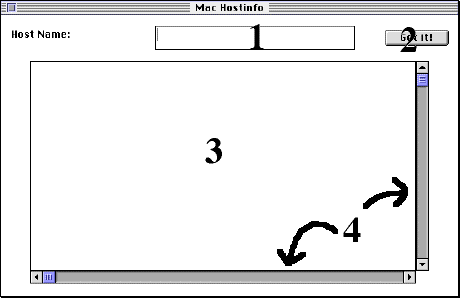 |
Macintosh Development |
[Home]
[About Us]
[People]
[Information Systems]
[Kerberos for Macintosh]
[Applications]
[Miscellaneous Documentation]
 |
Macintosh Development |
[Home]
[About Us]
[People]
[Information Systems]
[Kerberos for Macintosh]
[Applications]
[Miscellaneous Documentation]
Prior to starting this notebook, I spent time reading up on TCP/IP and looked at the code for the Athena Unix version of hostinfo. This past week or so, I've been brainstorming on how to design the GUI for the program. The Unix version of hostinfo has the following options:
(Taken from hostinfo help)
Usage: hostinfo (options) (host-names-or-addresses)
-h: output only hostname
-a: output only internet address
-i: output only host info record
-m: output only mx record
-q: disable additional query for hinfo & mx
-ns (server) ask specified name server
The user will be able to make queries by way of a dialog box, such as the following mock-up:

The input frame will be a text box where the user types in the name of the server he wants to recieve information on. The user should have the ablity to highlight text in the frame, to cut & copy text from the frame to the clipboard, to paste text from the clipboard to the frame, to delete text, and (maybe) to be able to drag and drop text to and from the frame.
The "Get it!" button executes the procedures that search for host information of the machine name entered into the input frame, using either a nameserver specified by the user or a default server. Results of the query will be printed in the output frame, unless an error occured, like the user entered an invalid server name.
The output frame will be a text box containing the results of a query for hostinfo. The user should be able to highlight text in the frame, copy text from the frame to the clipboard, and drag copies of highlighted text from the frame.
The scroll bars allows the user to move the text in the output frame to allow the user to view text that scrolls out of the frame's view. (May not be implemented if returned text for queries are small enough to fit in frame.)
The history menu will be a pop up menu in the dialog box that will contain previous queries, listed by the names of the machines queried in order they are queried. That is, when the user selects an item from the menu, the dialog box reverts to the state it was in when the query was made, with the name of the machine in the input frame, it's hostinfo in the output frame, and all flags and states reverted to what they were during the query. (The menu will be placed where the "get it" button is now, with the input frame and the button shifted to the left.
In addition to that, a feature that would be next to implement is to allow the user to have muliple dialog boxes on the screen that he/she can move and switch to and from at will. Unfortunately, dialog boxes (as defined) do not allow users to switch to windows outside of the current dialog box. As a result, I will use WIND resources to draw the "dialog boxes" and draw all of the buttons, controls, and text for them manually using my own procedures.
Questions or comments? Send mail to macdev@mit.edu
Last updated on $Date: 2003/11/18 21:59:37 $
Last modified by $Author: smcguire $